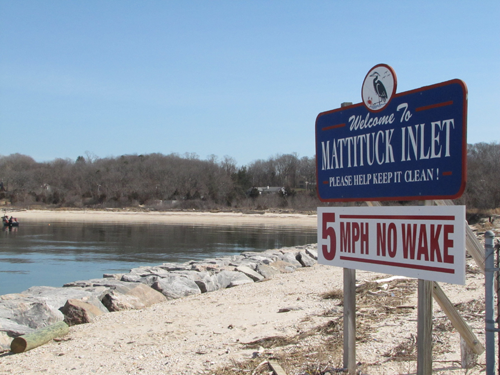Mattituck Inlet dredging set to start on Tuesday

After receiving approval from the state Department of Environmental Conservation, dredging at Mattituck Inlet is scheduled to start early next week.
Village Dock Contracting Inc. of Port Jefferson, which was contracted in mid-December to dredge the inlet, will begin what’s expected to be a month-long project on Tuesday, Jan. 21, said Southold Town attorney Martin Finnegan. Work on the $2.2 million project will proceed “24/7,” he said, and is expected to continue until Feb. 28.
State Department of Environmental Conservation regulations require waterway dredging to be completed by Jan. 15 to protect aquatic life, leaving U.S. Army Corps of Engineers officials in need of an exemption from that dredge window.
The federal government last year agreed to dredge Mattituck Inlet, for which the Army Corps is responsible — a project 15 years in the making — and to use the dredged material to rebuild the heavily eroded beach east of the stone jetties. The jetties, built in 1906, extend out into the Sound, interrupting the natural west-to-east movement of sand, known as the littoral drift. As a result, a large amount of sand has collected against the west side of the west jetty, leaving the beach to the east starved of sand.
The dredging work, during which close to 100,000 cubic yards of material will be removed from the inlet, will both widen and deepen the inlet channel to 11 feet below mean low tide, improving navigability. The dredged sand will be placed on the beach to the east in a 20-foot-wide strip about 4,500 feet long, starting at the eastern jetty, according to Congressman Tim Bishop’s office.
Ron McGreevy, a resident who helped in lobbying the federal government to undertake the project, said some sand will also be removed from the western side of the jetty and placed on the beach to the east, which, he noted, disappointed some residents on the western side.
According to a 2010 Army Corps study of the inlet, about 12,000 cubic yards of sand move along the beach from the west every year, collecting around different areas of the inlet — meaning additional dredging will be needed in the future as sand builds up over time.
The study found that each year, about 7,000 cubic yards builds up on the western side of the jetty; about 3,000 cubic yards moves into a shoal in front of the inlet’s entrance, essentially blocking part of it; and the remaining 2,000 cubic yards goes inside the inlet itself, building up and hindering vessels from safely navigating the waterway.
Mr. Bishop (D-Southampton), who has called on the federal government to take responsibility for the situation, and do something about, it since his start in Congress, said, “Recreational and commercial fishing is a big part of our heritage and we have an obligation to maintain navigable waterways that are also safe.
“It’s one of the four inlets in my district that the Corps is responsible for,” he said. “Mattituck is perhaps the least active, but that doesn’t make it any less important.”








